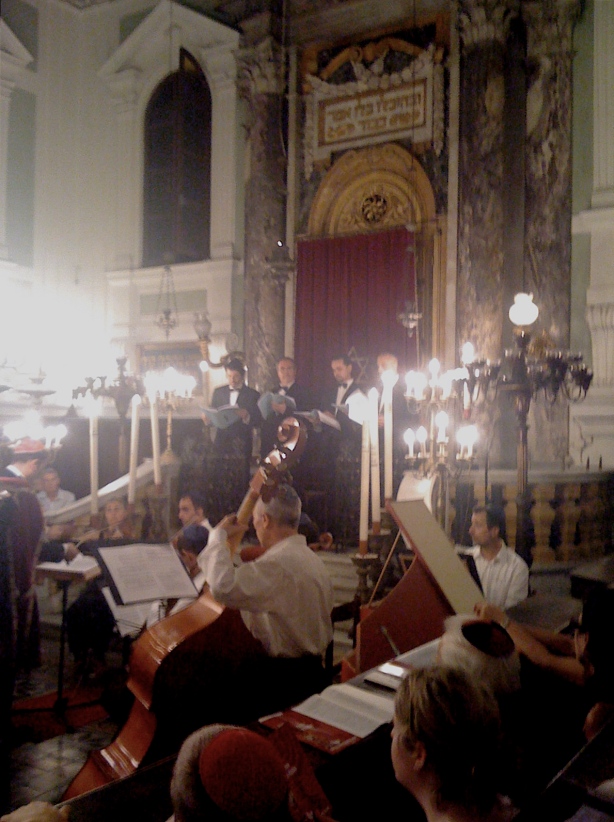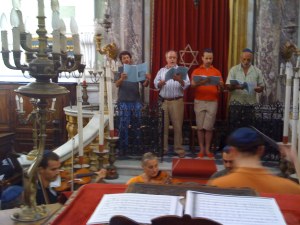So, I went to another conference last weekend. In Alessandria, Italy. A very interesting international symposium on Italian composer Antonio Brioschi (who florished around 1730-1750) that had many different institutions involved: the Music Department of the University of Milan (my alma mater), Ricordi, Sony BMG, and Atalanta Fugiens, an early music ensemble conducted by Vanni Moretto, who also happens to be an old friend (whom I had not seen in 20 years, yes t-w-e-n-t-y…).
Nu, what was I doing there? It so happens that one of the earliest sinfonie by Brioschi, an obscure composer whom, along with Sammartini, is at the origins of the new genre of the sinfonia (at a time when people were actually doing something interesting in Milan, my hometown: they were busy “inventing” human rights and the symphony – not bad, uh?) – so, one of Brioschi’s symphonies appears as an ouverture of a Hebrew cantata for Hosha’na rabbah, performed in Casale Monferrato in 1733.
I will post later on this cantata, which was performed in the synagogue of Casale Monferrato for the first time since 1733 last Sunday, September 17, 2008. Right now I am just copying the program of the entire, two-day conference below.
—
E così me ne sono andato a un altro convegno lo scorso fine settimana. Ad Alessandria. Un convegno molto interessante sul compositore italiano Antonio Brioschi (fiorito nel 1730-1750), che vedeva diverse istituzioni coinvolte: il Dipartimento di Musica dell’Università di Milano (la mia alma mater), la Casa Ricordi, la Sony BMG, e Atalanta fugiens, un ensemble di musica “antica” diretto da Vanni Moretto, che poi è un vecchio amico (che non vedevo da ben 20 anni, sì, proprio così).
E allora, che ci facevo lì? Beh, si tratta del fatto che una delle prime sinfonie del nostro Brioschi, un oscuro compositore che, insieme con Sammartini, è all’origine del nuovo genere della sinfonia (in un’epoca in cui la gente faceva cose interessanti a Milano, la mia città: tipo “inventare” i diritti umani e la sinfonia – mica male, no?) – allora, si dà il caso che una felle sinfonie di Brioschi sia stata inclusa, come ouverture, in una cantata ebraica per Hosha’na rabbah, eseguita a Casale Monferrato nel 1733.
Scriverò più avanti di questa cantata, che è stata eseguita nella sinagoga di Casale per la prima volta dal 1733 la scorsa domenica (17 settembre, 2008). Per ora copio qui di seguito il programma completo della conferenza, che è durata due giorni.
==================================================================
http://www.antoniobrioschi.org/seminario.php
Convegno Internazionale
Antonio Brioschi e il nuovo stile musicale del Settecento lombardo:
ricerca storico-critica, prassi esecutiva, aspetti produttivi
Alessandria, Palazzo Cuttica, 20 e 21 settembre 2008
* Associazione Atalanta Fugiens
* Sezione Musica del Dipartimento di Storia delle arti, della musica e dello spettacolo dell’Università degli Studi di Milano
* Fondazione Cassa di Risparmio di Alessandria
La riscoperta di Antonio Brioschi (fl. 1725 ca. – 1750 ca.) è lo spunto e l’occasione per una complessiva riconsiderazione del Settecento strumentale lombardo. Intorno a questo tema s’incentra il convegno, orientato da due direttrici di fondo. Da un lato, la verifica di un’ipotesi di lavoro o, se si preferisce, di una sfida critica e storiografica che riguarda il ruolo di Brioschi e degli altri autori milanesi – o comunque operanti in Lombardia – nella definizione di un nuovo stile strumentale di rilevanza europea; dall’altro, l’intento di accompagnare e integrare la ricerca musicologica con lo studio sulla prassi esecutiva. Il convegno segna del resto un primo importante momento di riflessione nell’ambito del progetto «Archivio della sinfonia milanese», che si propone di raccogliere il repertorio sinfonico del Settecento lombardo al fine di promuoverne lo studio, l’esecuzione e la diffusione. Il progetto punta infatti a coordinare gli aspetti della ricerca storico-critica, della prassi esecutiva, dell’organizzazione musicale e della produzione editoriale e discografica coinvolgendo diversi soggetti e istituzioni: anzitutto l’Associazione Atalanta Fugiens, la Sezione Musica del Dipartimento di Storia delle arti, della musica e dello spettacolo dell’Università degli Studi di Milano, Casa Ricordi, la Sony BMG Music.
Tra gli obiettivi principali del progetto vi sono:
* la creazione di un centro di ricerca dedicato alla raccolta sistematica, alla digitalizzazione delle fonti e allo studio dei compositori milanesi o comunque operanti in Lombardia nel corso del Settecento, e in particolare di quegli autori che manifestano un orientamento stilistico progressivo e una personalità di respiro europeo;
* la pubblicazione di una collana, edita da Ricordi, delle composizioni più significative di questi autori (i primi volumi saranno dedicati ad Antonio Brioschi, Fortunato Chelleri, Nicola Antonio Zingarelli); l’intento della collana è di offrire testi che corrispondano a limpidi criteri critici e musicologici e che, al contempo, soddisfino le esigenze della prassi esecutiva;
* la pubblicazione, in parallelo, di una collana discografica da parte della Sony BMG Music;
* l’organizzazione di corsi e seminari dedicati alla prassi esecutiva storica.
Sabato 20 settembre
ore 9.30
Saluti di benvenuto delle Autorità
Apertura dei lavori
Gianfranco Pittatore, Presidente Fondazione Cassa di Risparmio di Alessandria
Presiede Vanni Moretto
Cristiano Ostinelli
Luciano Rebeggiani
CESARE FERTONANI, La sinfonia “milanese” e il contributo allo sviluppo di un nuovo stile strumentale.
LUCA AVERSANO, Classicismo e musica strumentale nel Settecento italiano
BERTIL VAN BOEHR, A radical change; The influence of Brioschi on the Development of the Swedish Symphonies of Johan Helmich Roman
RENATO MEUCCI, Strumenti e strumentisti intorno a Mozart a Milano.
Ore 15.00
Presiede Bertil Van Boer
VANNI MORETTO, La sinfonia milanese del Settecento: aspetti e problemi di prassi esecutiva.
RUDOLF RASCH, Gli anni 1730 fra barocco e preclassicismo: la variazione formale nel repertorio sinfonico del centenario del Teatro di Amsterdam (1738).
FRANCESCO SPAGNOLO, Il mondo in Sinagoga. Dialoghi musicali tra ebrei e cristiani a Casale Monferrato (XVIII-XIX sec.)
MATTEO GIUGGIOLI, Intorno ad alcuni esempi di ‘sinfonismo’ lombardo: strategie retoriche a confronto.
Ore 21.00
Concerto, Cattedrale di San Pietro di Alessandria
Domenica 21 settembre
ore 9.30
Presiede Cesare Fertonani
SARAH MANDEL YEHUDA, Issues of Authenticity in Eighteenth- Century Sources of Symphonies: The Case of Antonio Brioschi.
BATHIA CHURGIN, A Brioschi Borrowing from Sammartini: The Andante from his Trio Symphony, Fonds Blancheton, Op. II , 61.
Interventi del “Gruppo di ricerca del Dipartimento di Storia delle Arti, della Musica e dello Spettacolo dell’Università degli Studi di Milano”.
DAVIDE DAOLMI, coordinatore
Luca Civelli Jacopo Franzoni Matteo Magarotto
Ore 17.00
Concerto, Sinagoga di Casale Monferrato






You must be logged in to post a comment.